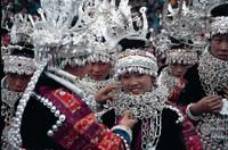|
|
|
Population
& Ethnic Groups
|
|

Dance
of Hani ethnic group.

Miao
girls in their holiday best.

Dong
girls.
??
|
Regional
Autonomy for
Minority Peoples
Equality,
unity, mutual help and common prosperity are the basic principles
of the Chinese government in handling the relations between ethnic
groups. The Constitution of the PRC specifies that all ethnic groups
are equal. The state guarantees the lawful rights and interests
of the minority peoples. Discrimination against or oppression of
any ethnic group is prohibited; all acts that undermine the unity
of the ethnic groups or create splittism among them are forbidden.
Big-ethnic group chauvinism, mainly Han-chauvinism, or chauvinism
on a local level, is banned. Every ethnic group has the freedom
to use its own spoken and written languages, and to retain or change
its customs.
In
accordance with these basic policies, China practices a system whereby
national minorities exercise regional autonomy. Where national minorities
live in compact communities autonomous organs of self-government
are established under the unified leadership of the Central Government.
The minority people shall exercise autonomous rights, be masters
in their own areas and administer the internal affairs of their
ethnic group. The National Minority Regional Autonomy Law adopted
in 1984 by the Second Session of the Sixth National People??s Congress
provides specific guidelines for guaranteeing that the constitutionally
decreed national minority regional autonomy system is carried out.
In addition to five autonomous regions (Inner Mongolia Autonomous
Region, founded on May 1, 1947; Xinjiang Uygur Autonomous Region,
founded on October 1, 1955; Guangxi Zhuang Autonomous Region, founded
on March 5, 1958; Ningxia Hui Autonomous Region, founded on October
25, 1958; and Tibet Autonomous Region, founded on September 9, 1965),
China currently has 30 autonomous prefectures and 120 autonomous
counties (or, in some cases, ??banners??), in addition to more than
1,300 ethnic townships. Self-government in autonomous national minority
areas is effected through the people??s congress and people??s government
at the particular local level. The chairperson or vice-chairperson
of the standing committee of the
|
| people??s
congress and the head of the government of an autonomous region, autonomous
prefecture or autonomous county should be from the area??s designated
minority people.Organs
of self-government in regional autonomous areas enjoy extensive self-government
rights beyond those held by other state organs at the same level.
These include enacting regulations on autonomy and special regulations
corresponding to local political, economic and cultural conditions,
having independent control of the local revenue, and independently
arranging and managing construction, education, science, culture,
public health and other local undertakings. The Central Government
has greatly assisted in the training of minority cadres and technicians
through the establishment of national minority universities (colleges)
and national minority cadre schools to supplement regular colleges
and universities. It has, in addition, supplied the national minority
autonomous areas with large quantities of financial aid and material
resources in order to promote their economic and cultural development. |
China's
Ethnic Minority Population and Distribution
(Date of the Fourth
National Census, July 1, 1990)
|
Ethnic
Group
|
Population(100,000)
|
Major
Areas of Distribution
|
|
Mongol
|
48.024
|
Inner
Mongolia, Xinjiang, Liaoning, Jilin, Heilongjiang, Gansu, Hebei,
Henan, Qinghai
|
|
Hui
|
86.120
|
Ninxia,
Gansu, Henan, Hebei, Qinghai, Shandong, Yunnan, Xinjiang, Anhui,
Liaoning, Heilongjiang, Jilin, Shaanxi, Beijing, Tianjin
|
|
Tibetan
|
45.931
|
Tibet,
Qinghai, Sichuan, Gansu, Yunnan
|
|
Uygur
|
72.070
|
Xinjiang
|
|
Miao
|
73.836
|
Guizhou,
Hunan, Yunnan, Guangxi, Sichuan, Hainan, Hubei
|
|
Yi
|
65.785
|
Sichuan,
Yunnan, Guizhou, Guangxi
|
|
Zhuang
|
155.558
|
Guangxi,
Yunnan, Guangdong, Guizhou
|
|
Bouyei
|
25.483
|
Guizhou
|
|
Korean
|
19.234
|
Jilin,
Liaoning, Heilongjiang
|
|
Manchu
|
98.468
|
Liaoning,
Jilin, Heilongjiang, Hebei, Beijing, Inner Mongolia
|
|
Dong
|
25.086
|
Guizhou,
Hunan, Guangxi
|
|
Yao
|
21.370
|
Guangxi,
Hunan, Yunnan, Guangdong, Guizhou
|
|
Bai
|
15.981
|
Yunnan,
Guizhou
|
|
Tujia
|
57.250
|
Hunan,
Hubei
|
|
Hani
|
12.548
|
Yunnan
|
|
Kazak
|
11.108
|
Xinjiang,
Gansu, Qinghai
|
|
Dai
|
10.254
|
Yunnan
|
|
Li
|
11.125
|
Hainan
|
|
Lisu
|
5.746
|
Yunnan,
Sichuan
|
|
Va
|
3.520
|
Yunnan
|
|
She
|
6.347
|
Fujian,
Zhejiang, Jiangxi, Guangdong
|
|
Gaoshan
|
0.029
|
Taiwan,
Fujian
|
|
Lahu
|
4.115
|
Yunnan
|
|
Shui
|
3.471
|
Guizhou,
Guangxi
|
|
Dongxiang
|
3.737
|
Gansu,
Xinjiang
|
|
Naxi
|
2.778
|
Yunnan,
Sichuan
|
|
Jingpo
|
1.193
|
Yunnan
|
|
Kirgiz
|
1.435
|
Xinjiang,
Heilongjiang
|
|
Tu
|
1.926
|
Qinghai,
Gansu
|
|
Daur
|
1.215
|
Inner
Mongolia, Heilongjiang, Xinjiang
|
|
Mulam
|
1.606
|
Guangxi
|
|
Qiang
|
1.983
|
Sichuan
|
|
Blang
|
0.824
|
Yunnan
|
|
Salar
|
0.875
|
Qinghai,
Gansu
|
|
Maonan
|
0.724
|
Guangxi
|
|
Gelo
|
4.382
|
Guizhou,
Guangxi
|
|
Xibe
|
1.729
|
Xinjiang,
Liaoning, Jilin
|
|
Achang
|
0.277
|
Yunnan
|
|
Pumi
|
0.297
|
Yunnan
|
|
Tajik
|
0.332
|
Xinjiang
|
|
Nu
|
0.272
|
Yunnan
|
|
Ozbek
|
0.148
|
Xinjiang
|
|
Russian
|
0.135
|
Xinjiang
|
|
Ewenki
|
0.264
|
Inner
Mongolia, Heilongjiang
|
|
Deang
|
0.155
|
Yunnan
|
|
Bonan
|
0.117
|
Gansu
|
|
Yugur
|
0.123
|
Gansu
|
|
Jing
|
0.187
|
Guangxi
|
|
Tatar
|
0.051
|
Xinjiang
|
|
Drung
|
0.058
|
Yunnan
|
|
Oroqen
|
0.070
|
Inner
Mongolia, Heilongjiang
|
|
Hezhen
|
0.043
|
Heilongjiang
|
|
Moinba
|
0.075
|
Tibet
|
|
Lhoba
|
0.023
|
Tibet
|
|
Jino
|
0.180
|
Yunnan
|
|



